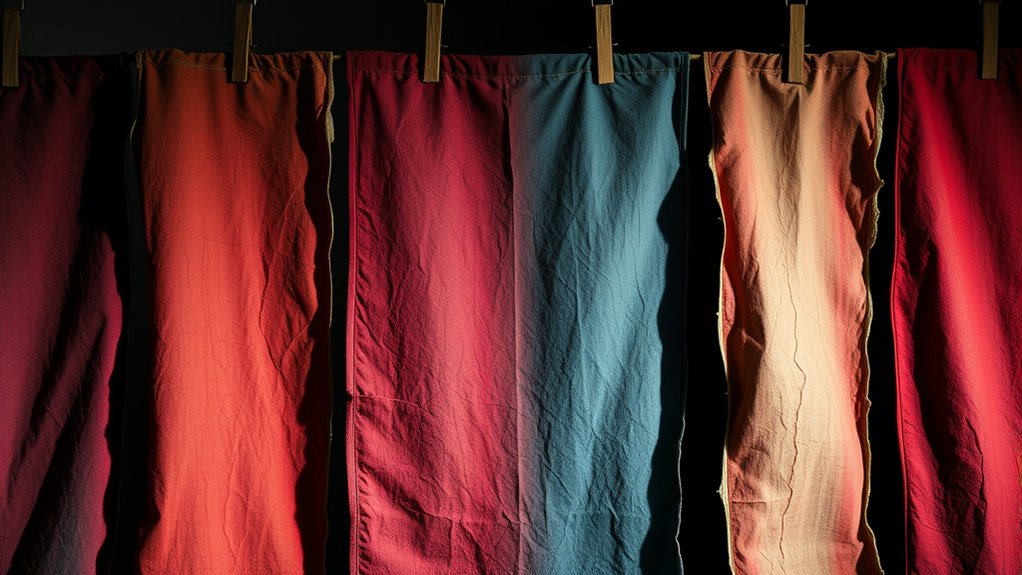Over decades, environmental factors like sunlight, pollution, humidity, and temperature changes cause paint and fabric colors to fade and shift. Exposure to UV rays breaks down dye molecules and pigments, while chemical reactions from pollutants weaken the colors. Material composition also matters; organic dyes fade faster than synthetic ones, and natural fibers are more vulnerable. To better understand how to protect vibrant hues over time, explore how preservation techniques and material choices can help maintain color longevity.
Key Takeaways
- Chemical reactions within pigments cause degradation, leading to color fading over time.
- Exposure to light, especially UV rays, accelerates photobleaching and discoloration.
- Environmental factors like humidity and pollution chemically attack dyes and paint layers.
- Organic pigments tend to fade faster than inorganic ones, shifting from vibrant to dull hues.
- Preservation techniques such as controlled environments and UV protection help slow color drift.
The Science of Color: How Pigments Change Over Time

Understanding how pigments change over time begins with recognizing that many colors you see in old artworks or faded fabrics result from chemical reactions within the pigments themselves. These reactions cause pigment degradation, breaking down the original chemical structure and altering their appearance. Over decades, exposure to light, heat, and moisture triggers these chemical reactions, leading to fading, discoloration, or shifts in hue. For example, organic pigments tend to degrade faster than inorganic ones, changing from vibrant shades to duller tones. You can think of pigment degradation as a slow chemical process that transforms the original color. Additionally, the chemical composition of pigments influences their stability and how they age over time. This natural breakdown explains why many historical pieces don’t look like they did when first created, highlighting the importance of understanding these chemical reactions to preserve artwork and textiles.
Environmental Factors That Accelerate Fading
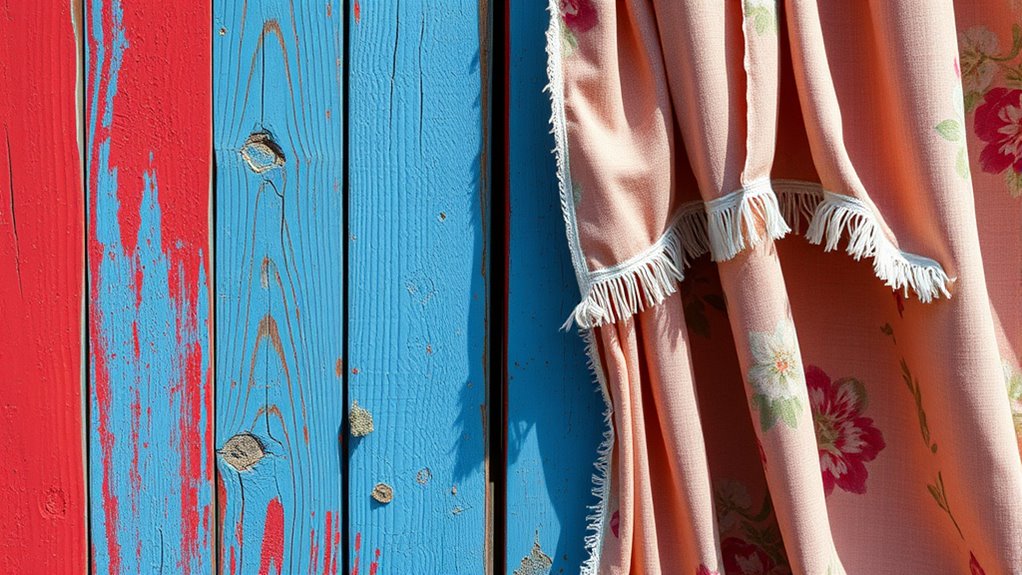
You might notice that prolonged sunlight exposure speeds up fading, breaking down pigments over time. Air pollution introduces chemicals that can weaken colors and cause discoloration. High humidity and moisture, meanwhile, promote mold and deterioration, further accelerating color loss.
Sunlight Exposure Effects
Sunlight exposure considerably accelerates the fading of colors over time, especially when materials are left in direct sunlight for extended periods. UV degradation plays a significant role in breaking down the chemical bonds in dyes and pigments, leading to color loss. This process, known as photobleaching effects, causes vibrant hues to become dull and faded. The ultraviolet rays damage the molecular structure of paint and fabric, weakening their integrity and altering their appearance. You might notice that outdoor furniture or curtains fade faster than indoor items, simply because they’re exposed to more sunlight. To preserve your colors, it’s best to minimize direct sunlight exposure or use protective coatings that filter UV rays. Additionally, celebrity lifestyle insights reveal that many opt for specialized protective coatings to maintain the vibrancy of their outdoor decor. Understanding these effects helps you take better care of your belongings over time.
Air Pollution Impact
Have you ever wondered how air pollution speeds up the fading of colors? Urban smog and industrial emissions release pollutants like sulfur dioxide and nitrogen oxides into the air, which settle on surfaces over time. These particles react with sunlight and moisture, creating acidic compounds that attack dyes and paint layers. This chemical activity breaks down color molecules, causing fabrics and painted surfaces to lose vibrancy faster. The more polluted an area, the harsher this process becomes, especially in busy industrial zones or cities with heavy traffic. Over decades, continuous exposure to these pollutants markedly accelerates fading, making colors appear dull and washed out much sooner than in cleaner environments. Additionally, chemical reactions between pollutants and surface materials contribute further to the breakdown of color integrity. Understanding this impact helps you better protect and preserve your belongings from environmental damage.
Humidity and Moisture
Ever wonder how humidity and moisture speed up the fading of colors? Humidity effects can weaken paint and fabric fibers, causing colors to lose vibrancy faster. When moisture is present, it accelerates chemical reactions that break down dye molecules, leading to duller hues over time. High moisture levels promote mold and mildew growth, which stain and damage surfaces, further compromising color integrity. Fluctuations in humidity cause materials to expand and contract, creating microscopic cracks that let fading agents penetrate deeper. This constant cycle of wet and dry conditions hastens the deterioration process. Additionally, proper preservation techniques can help mitigate moisture-related fading. Moisture impact is especially noticeable in environments lacking proper ventilation or controlled climate, making it vital to manage humidity levels to preserve your paint and fabrics’ original colors longer.
Material Composition and Its Impact on Color Stability
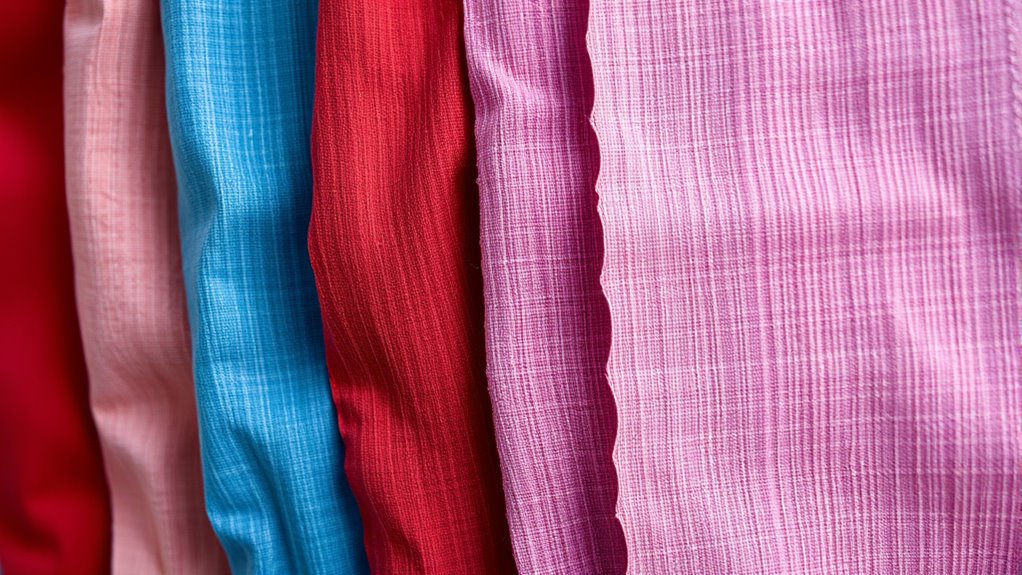
The type of pigment and fabric fibers directly influence how well colors hold up over time. Some pigments are more resistant to fading, while others break down quickly, affecting long-term appearance. Similarly, the fiber composition determines how colors interact with environmental factors, impacting overall stability. Choosing preppy dog names that reflect a sophisticated aesthetic can also be influenced by the durability and appearance of the materials used in fashion and accessories.
Pigment Type and Durability
Different pigment types substantially influence how colors fade or stay stable over time, as their material composition determines their resistance to environmental factors. Natural dyes often fade faster because they are more vulnerable to light exposure, humidity, and pollution. Conversely, synthetic pigments are generally more durable, designed to withstand harsh conditions and retain their vibrancy longer. Your choice of pigment impacts longevity: natural dyes may create a softer, authentic look but require careful preservation, while synthetic pigments offer greater stability for long-term applications. Additionally, the chemical composition of synthetic pigments contributes significantly to their enhanced durability and resistance to environmental degradation.
Fabric Fiber Composition
Fabric fiber composition plays a crucial role in how colors hold up over time. Different fibers respond uniquely to dye chemical treatments, influencing color retention. Natural fibers like cotton or wool often have weaker fiber strength, making them more susceptible to fading and wear, especially if dyes aren’t well formulated. Synthetic fibers such as polyester or nylon tend to have higher fiber strength, which helps them resist fading caused by washing or sunlight exposure. The type of fiber impacts how well the dye chemical bonds, affecting color stability over decades. Choosing fabrics with durable fiber strength ensures colors remain vibrant longer. Understanding material composition allows you to select textiles that better resist the effects of aging, maintaining their original hue despite environmental challenges. Additionally, the fiber durability of a fabric significantly affects its ability to withstand environmental stressors over time.
The Role of Light Exposure and UV Rays
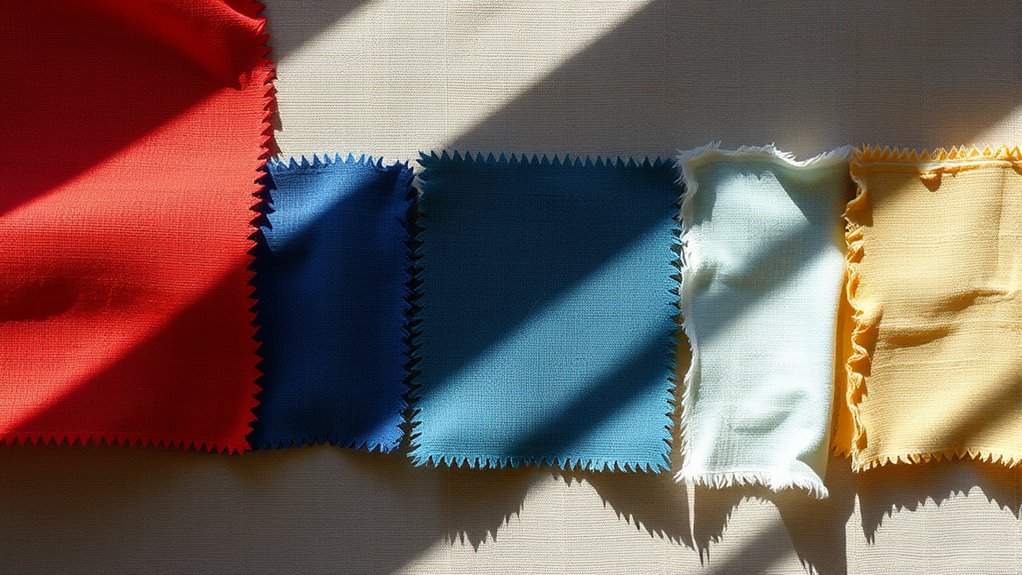
Light exposure, especially to ultraviolet (UV) rays, plays a significant role in causing color drift over time. UV degradation breaks down dye molecules and paint pigments, leading to fading and color shifts. The level of light intensity directly impacts the rate of deterioration; higher light levels accelerate fading. To understand this process better, consider these factors:
UV light damages dyes and pigments, causing fading and color shifts over time.
- UV rays penetrate surfaces, initiating chemical reactions that weaken color vibrancy
- Continuous exposure causes cumulative damage, making fading more pronounced over decades
- Different materials have varying sensitivities to UV degradation, influencing their longevity
- The presence of essential oils in some paints or fabrics can either slow or accelerate UV-induced fading depending on their chemical composition.
Techniques for Preserving Paint and Fabric Colors
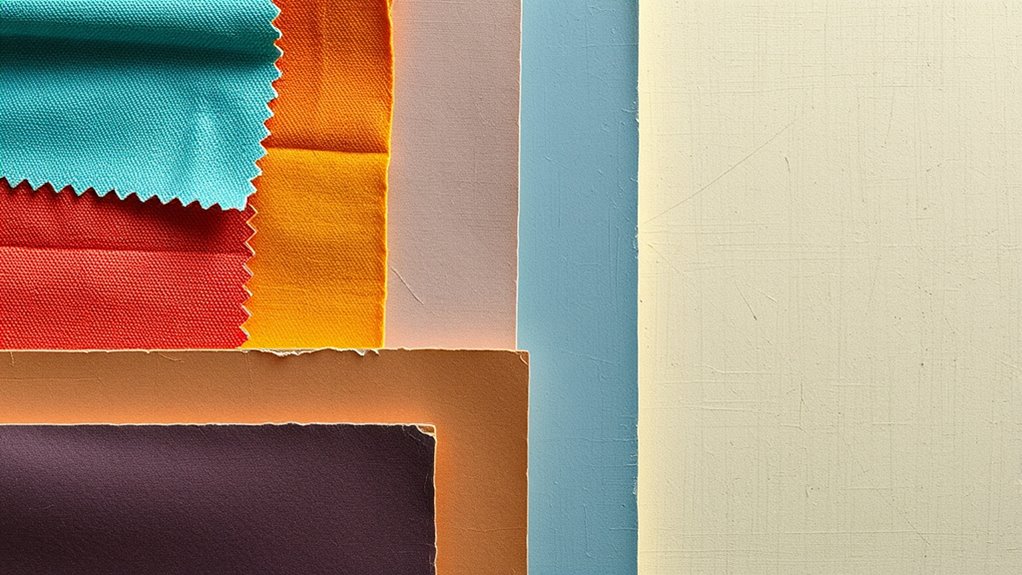
To combat the color changes caused by UV exposure, employing effective preservation techniques is essential. You can start with historical restoration methods that carefully analyze original materials, helping you select appropriate conservation strategies. Implementing dye fixation techniques ensures dyes stay bonded to fabrics, reducing fading over time. Using UV-filtering glass or coatings on paintings and textiles provides a physical barrier against harmful rays, slowing color deterioration. Proper climate control—maintaining stable temperature and humidity—also minimizes chemical reactions that cause fading. When restoring or preserving valuable pieces, consulting conservation specialists can help you choose treatments that respect the item’s historical integrity. Additionally, understanding paint and fabric types can guide you in selecting the most suitable preservation methods. Combining these approaches allows you to preserve the vibrant colors and details of your artwork and textiles for decades to come.
Advances in Colorfast Materials and Treatments

Recent advances in colorfast materials and treatments have markedly enhanced the durability of paints and textiles, making it easier to preserve their vibrant hues over time. Innovations in dyeing techniques, like low-impact and digital dyeing, allow for more uniform and long-lasting colors. Chemical treatments now protect fabrics against UV rays, moisture, and microbial damage, considerably reducing fading. These treatments often involve applying protective coatings or mordants that lock in dyes more effectively. Additionally, new synthetic pigments resist chemical degradation, maintaining brightness even after prolonged exposure. Together, these developments help extend the lifespan of colored materials, ensuring they stay vivid for decades. Incorporating advanced chemical treatments further enhances color retention by providing an extra layer of protection against environmental factors.
Practical Tips for Maintaining Vibrant Hues Over Decades
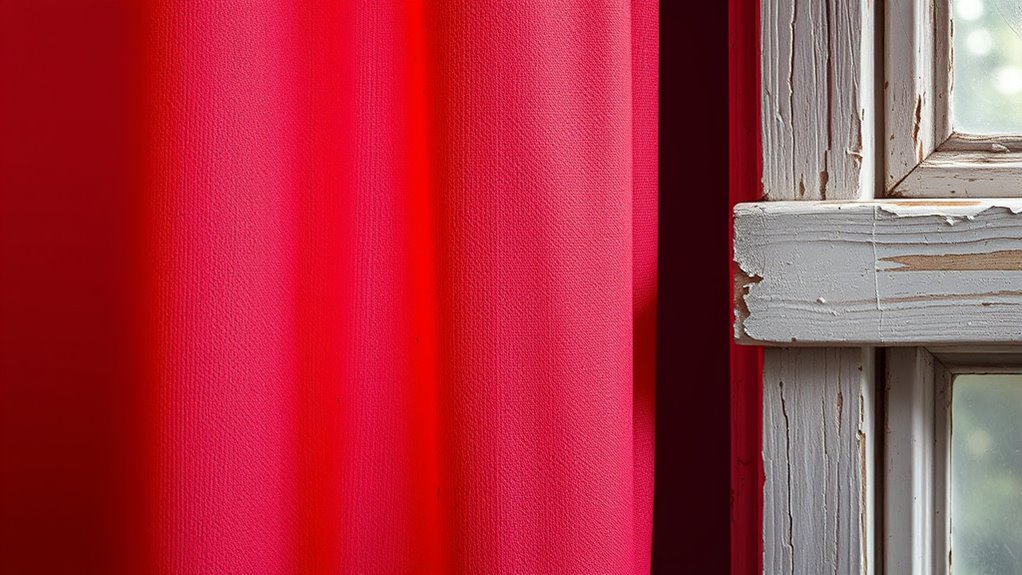
Maintaining vibrant hues over decades requires consistent care and mindful practices. Start by regularly inspecting your paint and fabric for signs of fading or discoloration. When touch-ups are needed, focus on color matching to ensure seamless repairs; this prevents noticeable differences and preserves the overall vibrancy. Proper dye fixation is essential when washing or cleaning fabrics—use gentle detergents and avoid harsh chemicals that can weaken dye bonds. Protect painted surfaces from direct sunlight by applying UV-protective coatings or using curtains, which slow down fading. Store fabrics in cool, dark places to minimize exposure to light and temperature fluctuations. Additionally, understanding digital literacy can help seniors utilize technology to monitor and maintain their home environments, ensuring ongoing color vibrancy. By paying attention to these details, you can markedly extend the life of your colors and keep your spaces looking fresh and vibrant for decades.
Frequently Asked Questions
Can Artificial Lighting Affect Color Longevity Differently Than Natural Sunlight?
Artificial lighting can impact color longevity differently than natural sunlight because it often emits specific wavelengths that may accelerate fading. You’ll find that artificial lighting, especially if it contains UV components, can weaken color preservation over time. To protect your painted surfaces or fabrics, use lighting with low UV emissions and consider UV-filtering bulbs, which help maintain vibrant colors and extend their lifespan better than standard artificial lighting.
Do Specific Colors Fade Faster Than Others Over Time?
Some colors fade faster than others, and this isn’t just a small difference—it’s like watching a vibrant rainbow turn into a dull gray. Bright reds and blues often struggle with pigment stability, leading to quicker color loss, while earth tones tend to hold their color better due to superior pigment stability. Your choice of color directly impacts long-term color retention, so opt wisely if you want your decor to stay stunning for decades.
How Do Indoor Versus Outdoor Environments Impact Color Durability?
Indoor environments generally help your colors last longer because indoor lighting is usually less intense, and you avoid outdoor exposure that accelerates fading. Outdoor settings expose your paint and fabric to direct sunlight, rain, and pollution, which cause faster color drift. To protect your items, consider using UV-resistant coatings or keeping them indoors when possible. This way, your colors stay vibrant and true over the years.
Are There Historical Techniques That Help Preserve Original Paint Colors?
You can safeguard original paint colors through historical preservation techniques that focus on pigment stability. By carefully selecting and applying historically accurate pigments, restorers maintain the artwork’s authenticity and vibrancy. These methods often involve specialized cleaning and conservation processes that protect the paint’s integrity over time. While fading can evoke nostalgia, these techniques ensure your cherished pieces retain their original hues, connecting you to history through enduring color.
Can Certain Cleaning Methods Accelerate Color Fading?
Yes, certain cleaning methods can accelerate color fading. When you use harsh cleaning agents, they can trigger chemical reactions that break down dye molecules in paint or fabric. This process weakens the color, causing it to fade faster over time. To protect your items, avoid aggressive chemicals and opt for gentle cleaners, ensuring you don’t unintentionally speed up the fading process.
Conclusion
To keep your colors vibrant for decades, understanding how pigments fade is key. Did you know that studies show over 70% of artworks lose their original hue within 50 years due to environmental factors? By controlling light exposure, choosing stable materials, and applying modern treatments, you can profoundly slow this process. With these strategies, you’ll preserve your paint and fabric colors longer, enjoying their beauty for generations to come.

